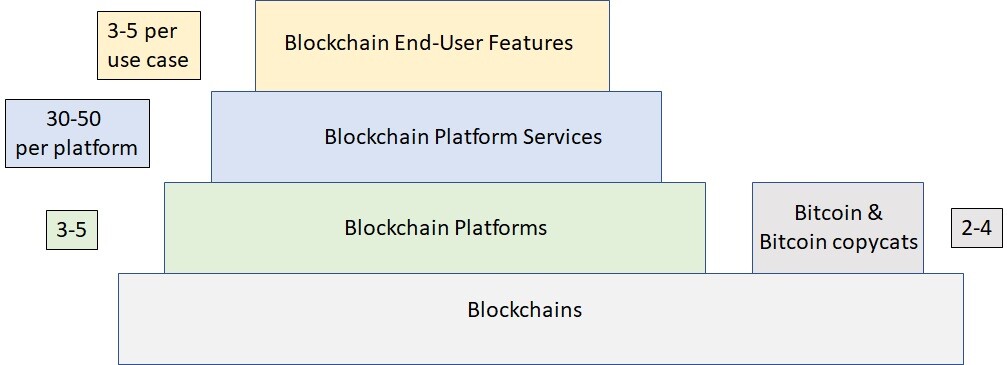
As of today, CoinMarketCap states there are 9,924 cryptocurrencies. Does that make sense? How many do we actually need? To answer that we have to go back to our categorization diagram in my second blog post (Crypto-Technology 101) to reason about a reasonable range to satisfy each category. Here is a revised diagram that includes a bounded range for each category.

Two differences between this diagram and the diagram in the Crypto-Technology 101 article are the lowest level (BlockChains) and the new category which just sits on the blockchain to represent Bitcoin and its ilk. So, that gives us 4 categories where we need to define a bounded range (lower-bound to upper-bound) that represents a reasonable number of candidates required to "fill a category". The way to think about filling these categories would be to compare the whole process to how we would consumer products. For example, let's say you wanted to answer the question - how many car companies do we need in the marketplace? The answer is always more than one because they can compete on offering different features in cars, offering different prices, and offering different services. Or, another way to think about it would be how many "brands" of a product do we need to satisfy a market? For example, how many brands of orange soda are too many?
The numbers above are a conservative estimate of need in order to satisfy the market for crypto-currencies based upon technical need. Let's go through each category and define its technical need and then its "reasonable range".
- Bitcoin and Bitcoin copycats (aka "digital money") - there is only 1 bitcoin. So for digital money, you could make an argument that is all you need as there are not many variants in the features of digital money. If you think that "scarcity" is a feature of the bitcoin model, you could certainly include a few copycats that compete on that feature. The reasonable range for digital money is 2-4 currencies ... after that, they are competing at the fringes.
- Blockchain Platforms - platforms like Ethereum, Cardano, and Polkadot provide a development environment for blockchain programs to build new digital assets and new digital services on top of any type of blockchain. New digital asset types like NFTs, supply chains, and other non-financial ledgers will continue to make these platforms more valuable. These development platforms are similar in scope and complexity to operating systems. So, when you think of the addressable market of developers, not too many platforms will survive. Look at the small number of cellphone development environments (chiefly iOS and Android) to get a feel for the number of platforms we need in this space. I foresee three to five major platforms competing with features, ease of development, programming language support, and libraries. That is not to say there won't be more platforms that attempt to compete ... but typically you have the top 3 and "everybody else".
- Blockchain Platform Services - So, for each platform, you have developers building applications. These developers don't want to build everything from scratch because they want to accelerate their time to market. To achieve a full-featured product in record time they are willing to pay for application services like security, identity management, data access, file storage, logging, search, etc. How many services does an application need? This will follow a similar pattern to web development and there are not an infinite number of services you need to build a web application. So, my conservative estimate of 30-50 per platform will follow the same formula where a smaller percentage (say 20-30%) are "must-have" services and the other 70-80% are nice-to-have. This still puts a cap on the number of successful services you need for each platform. One more note on this - do these services really need their own currency? Since they are exclusive to a particular platform, they could just use the currency of the platform as a fee for their service. In the current frenzy, it seems to be "Currency for Currency's sake".
- Blockchain End-User Features - Just like brands of soda, where you can have 3-5 major competitors per flavor; you can have 3-5 major competitors for each distinct end-user "use case". A "Use case" is a single scenario that provides value to the end-user. For example, a feature of traditional banks is a checking account where a consumer can write checks to withdraw from the account after they have deposited money into the account for safekeeping. In the same way, some end-user features of blockchains are things like an NFT gallery, the ability to send money across the globe, the ability to share virtual game assets across games, etc. Each end-user use case can have 3-5 major competitors for that "space". For argument's sake, let's say there are currently 50 distinct end-user use cases (I don't think there are that many but let's be generous). That would mean we need 5 X 50 currencies or 250.
So, if we tally up all the categories, here is my conservative estimate for how many currencies we need for today's "crypto" market:
4 (bitcoin & competitors) + 5 (platform competitors) + 250 (total service competitors) + 250 (total use case competitors) = 509.
This means that a shakeout of grand proportions will be occurring as the market separates the wheat (as described above) from the chaff (the other 8000+ wannabes). Let the great winnowing begin!











